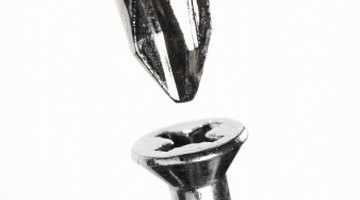Ways to Get a Stuck Screw Loose
Table of Contents
Screws are clever fasteners. They securely hold wood and metal and, unlike nails, can be removed -- until they become stuck. Screws become stuck for lots of reasons: rust or paint has locked them in, the head has been stripped or knocked off or they were driven in at an angle.

Removing them may seem an impossible task, but with the right techniques and tools, the task can be accomplished.
Rusted In
Use a penetrating oil such as WD-40 to dissolve the rust. Add a few drops at the screw head and let it drip down the shaft. Wait 10 to 15 minutes for the oil to work, although it may require a few hours or even overnight to dissolve heavy rust.
Painted On

Heat is one way to remove paint from a screw head – but use caution around flames and paint. Hold a large nail with pliers and use the flame from a lighter or match to heat the nail head. Press the nail head on the screw head to melt the paint. The screw will expand, so use ice to cool and contract it before removing it.
Misaligned
Screws stuck at an angle can often be coaxed out by placing a flathead screwdriver at the end of one slot and lightly tapping the screw counterclockwise.
Stripped Head
You will need to make a new head for a stripped screw. Use a file or roto-tool to carve a groove in the screw head, then use a strong flathead screwdriver to remove it.
Headless Screw
When the head has been knocked off a screw, you may decide it is not worth the effort to extract it and decide instead to nail it in and caulk over it. If the screw must come out, use needlenose pliers to turn the screw out.
Screw Extractor
This option requires a special tool and drilling a pilot hole in the stuck screw. Insert a screw extractor that is slightly smaller in diameter than the stuck screw and turn it counterclockwise until it engages and removes the screw. Screw extractors are available from tool corrals in hardware stores and home improvement stores and are a must for anyone doing a lot of carpentry work.
Last Resort
You may need to drill out a stuck screw using an electric drill. Use a drill bit the same size as the screw and aim straight down the middle of the screw. This will not work if the screws are stainless steel or if a screw extractor got stuck. Wear protective goggles when using a drill.
Preventing Stuck Screws
When working with screws, pass over bargain-priced screwdrivers and choose a strong, professional quality one. This is especially important for Phillips head screws. Use the right size screwdriver for the screw and, to prevent stripping, do not push too hard on the screw head. A tip from the pros: Dip the screwdriver bit in valve grinding compound for a better grip with the screw head.
The Drip Cap
- Screws are clever fasteners.
- Heat is one way to remove paint from a screw head – but use caution around flames and paint.
- Use a drill bit the same size as the screw and aim straight down the middle of the screw.
- This will not work if the screws are stainless steel or if a screw extractor got stuck.
- When working with screws, pass over bargain-priced screwdrivers and choose a strong, professional quality one.
References
Resources
Writer Bio
Alliene Turner began her writing career in 1980 as a technical writer for computer and data communications companies in California's Silicon Valley. She has a Bachelor of Arts in English from California State University, East Bay, and a Master of Library Science degree from San Jose State University.
Photo Credits
- Thomas Northcut/Photodisc/Getty Images
- Thomas Northcut/Photodisc/Getty Images
- Jupiterimages/Photos.com/Getty Images
More Articles



